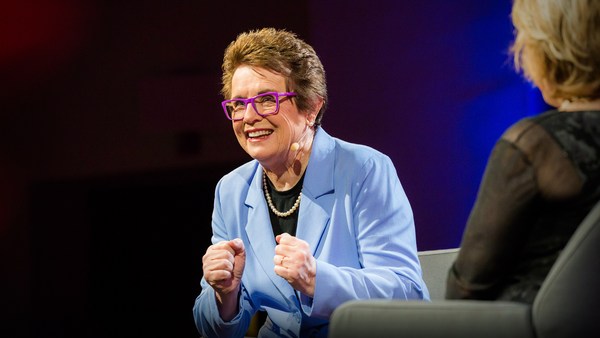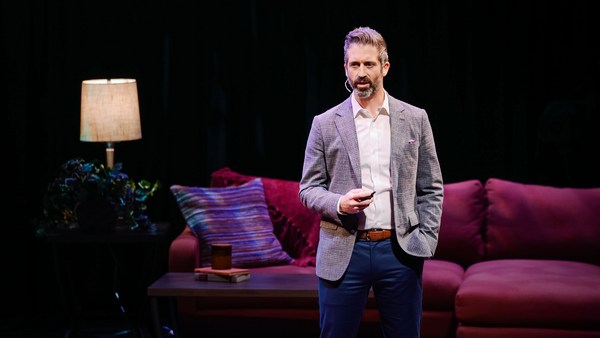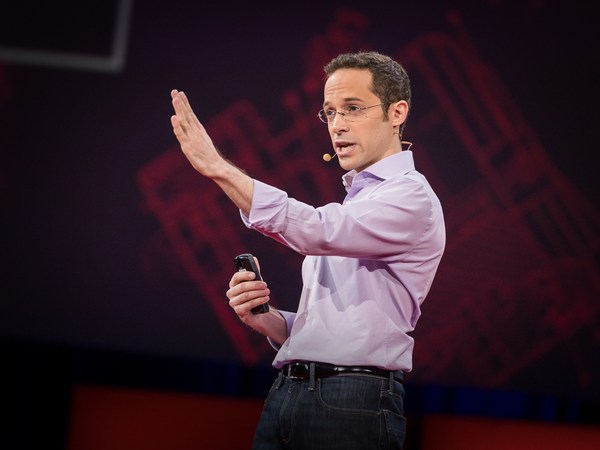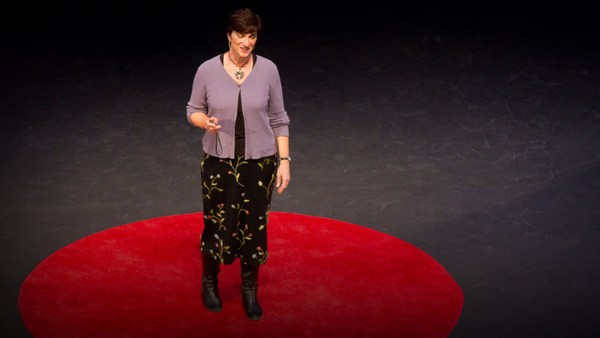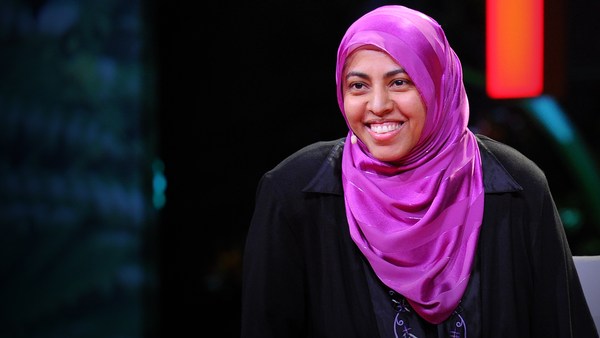Did you know that a crowd of New Yorkers once filled a hall, with thousands more awaiting word outside, and that the police had to come and forbid the selling of additional tickets, and that the "New York Times" used the phrase -- a phrase not yet a cliché -- that people were "packed like sardines"? And did you know that this frenzy was all because people were desperate to watch a woman walk in circles on sawdust?
(Laughter)
The sport was pedestrianism -- when watching people walk was America's pastime.
(Laughter)
I won’t get too deep into the story of our pedestrian, Ada Anderson, and the breathless “New York Times” articles about her walk: 2,700 quarter miles in 2,700 consecutive quarter hours.
I bring up this long-ago event for a singular purpose: to question what you think you know about why we watch sports. If people lost their minds watching someone walk in circles,
(Laughter)
what can this teach us about the heart of sports?
Understanding what compels us to watch sports, it's not just a thought experiment, although it is that, but it's more. It could have tangible effects. If we're willing to inspect what actually spikes our heart rate and pushes us to the edge of our seats, instead of just assuming we know, we can all, collectively, make the sports world a more equitable place. I didn't say "equal," I said "equitable." Fair, evenhanded, just.
Often, if you ask someone why they watch sports, they will tell you because they want to watch the best of the best. Anything else ... isn't worth their time. This reasoning ... it presents itself as biological. The men’s sprint champion -- always a half-second faster than the women's sprint champion. The men of the NBA -- most of them can jump higher than the women of the WNBA, and on, and on ... If we passively accept this premise that the only sports worth watching are those played at the apex of humanity, then we have baked into our sports world a reason for why women's sports don't ... and can't ... and won't matter.
For example: "Call me when women can dunk" is a thing that people have long said.
(Laughter)
Yeah, alright, so we're dunking now.
(Laughter)
"Actually, you know what? Call me when women can do 360 dunks."
2050 here, on the line. “Yeah, alright. We’re doing 360 dunks now too.
Ah, yeah, alright. We’ll call you, then.”
You get it. So let me lay out my theory for you. My theory about what actually compels us to watch sports. I spent seven years as a columnist and feature writer at ESPN, and I did shows like "Around the Horn," "Outside the Lines," "First Take." And we would always look at the sports calendar and try to pinpoint moments when women's sports would be big -- like, really big. And it was always the same two events, the Olympics, then the World Cup. Then, the Olympics. Toss some tennis in there, but mostly the Olympics and the World Cup. And so we got to thinking: What is it about these two events? What are the common factors that allow women's sports to transcend for these fleeting moments? Because even at the Olympics, the men's swim times are just a fraction of a second faster than the women's.
These two events have two crucial elements in common: stakes and storylines. This is what burns at the center of sports. In the Olympics, we have all agreed a gold medal matters. Same with the World Cup. And now, paired with these agreed-upon stakes, we also have -- at the Olympics and the World Cup -- very obvious storylines. One person has a USA jersey on, someone else has a different country's jersey on. Alright. We’ve got agreed-upon stakes, we’ve got very obvious storylines -- of course, now, we're going to have a commitment to even deeper storytelling, which is how we end up teary-eyed after a three-and-a-half-minute NBC vignette about a Romanian gymnast.
(Laughter)
You have everything you need, now, for the next two hours of competition. An Olympic gold medal is on the line. And you’ve got your storyline. A Romanian gymnast desperately overcoming the odds. Boom.
Storylines drive up the stakes. Higher stakes -- more storylines, and on and up we go.
Every so often, a female athlete or a team, they will hit the tipping point. We understand their storylines, we’ve got the stakes. Here, I'm thinking Serena Williams, Simone Biles, Ronda Rousey, Megan Rapinoe. Right? These are the outliers. And having representation matters. But what tends to happen is that these handful of female athletes carry the media burden for all of women's sports. Not only that -- the media gets to say "Yeah, we checked that box, we're good. We did that thing, we put so-and-so on the cover, like, seven years ago. We're good." What doesn’t happen is the pursuit of additional storylines, expanding the breadth of our storytelling, which is what is continually happening on the men's side.
When I worked at ESPN and I would do a TV show, I was in the production room, and I was always pitching women's sports stories. It almost never worked. Every once in a while, it would work. And the thing about doing sports on TV ... is that you are not actually an expert at everything you're talking about.
(Laughter)
But you read, you do your homework, you figure out a position. But this thing would happen when we would do a women's sports segment: Many of the other men on the segment ... didn’t really do their homework. So they were kind of "blah." Then, the segment would be kind of "blah." There's actually a term for this, it's called "gender bland." And then, the segment would end, and the producer would be like, "See? This is why we never do women's sports, because they're boring." When a men's segment fell flat, the problem was us. We would redo it. "Alright, come on, do your homework. Pick it up. We're doing that again." When a segment on women's sports fell flat, the problem was women's sports.
This is a microcosm for how this plays out across media. Never finding the new angle, never finding the new story. So what you do is you rely on the millions of stories that already exist. And you know what already exists? Every men's sports story imaginable.
(Laughter)
The reality is that just existing in our culture, you will know a dozen men’s storylines. I mean, these things are literally push-notified to your phone. Or you're sitting behind someone on an airplane, and you can’t help but see what they’re watching on ESPN. Or you’re at a bar, or a doctor’s office, and the talking heads are giving you the latest NBA drama. In America, osmosis will have you knowing men’s sports storylines.
(Laughter)
And by the way, when men have a daughter and they finally get women's sports, what they're really saying is, they finally have a front-row seat to the stakes and the storylines.
Let's go back in time again. Philadelphia, 1931. The Philadelphia Quicksteppers, an all-Black women's basketball team, led by a legend, Inez Patterson. Patterson, she knows a thing or two about storylines. She's ahead of her time. So she goes to the local all-Black newspaper, "The Philadelphia Tribune," and she proposes a deal. Sponsorship. Storylines in exchange for naming rights. This may very well be the first naming-rights deal in history. The Philadelphia Quicksteppers become the Philadelphia Tribunes. And I bring this up because the very next year, 1932, there's an intracity rival -- the Germantown Hornets with Ora Washington, very famous player. And they decide, the two of them -- Germantown, the Tribunes -- to play a five-game series to determine the best team in Philadelphia. Remember, storylines was part of the deal. Five-game series goes to a fifth game. And this is how the "Tribune" writes about the atmosphere in game five, 1932: "The cash customers fanned to fever heat by the ardor and closeness of combat gave outlet to all kinds of riotous impulses."
Alright? This may not sound familiar yet, but our girl, Ada Anderson? 1879, the "New York Times" writes about her walk. Her walk. "Many women were seen to faint in the dense crowd, but as they could not be carried out, it is not known what became of them."
(Laughter)
Hot damn, y'all, people loved ladies' sports, right?
(Laughter)
I mean ...
(Applause)
Who knew? Well, wherever you find compelling storylines and agreed-upon stakes, you will find people on the edge of their seat. No matter the vertical leap of the participant.
So ... Who tells the storylines of women’s sports today? Many of you will know the statistic I'm about to put up. University of Southern California, Purdue University, released in 2021, studying the year 2019 in sports media coverage. Of all of the minutes of ESPN's SportsCenter in 2019, 5.1 percent of them given to women's sports. You know what's really sad about this number? It's that it's not even as high as it looks, because 2019 was a Women's World Cup year.
Audience: Woo-hoo.
KF: What happens when you take out the Women’s World Cup minutes? 3.5 percent of all of the minutes of SportsCenter ... given to women's sports. Now what if I told you that number is even higher than it seems? Because what mostly makes up that number is, like, a game recap, a quick highlight. We call these "one-and-dones." There is nothing to think about. There's no follow-up. It is a “storyline” for a reason, because a "line" keeps going.
(Laughter)
A game recap is not a storyline. What drives interest in sports are the heroes and the villains, and the "Were they paid too much?" and "Should that coach be fired?" Something to really sink your teeth into and to stake a position on.
Do you know that ESPN has had the rights to the WNBA all 26 years of the league's existence? And in that time, not one studio show was ever made to introduce people to these storylines of the WNBA. People will tell you that number reflects consumer demand. But that number reflects one thing -- that number. Who can want more of something they have never been given? And how can we believe we want more of something if the reasons for not wanting it are biological? That feels pathological.
Remember Ada Anderson? Remember the Philadelphia Tribunes? "The cash customers fanned to fever heat." And why did they fan the fever heat? Because our collective love of sport is deep, and it's human, and it's driven by deep and human motivations. The physical expression of athleticism is just one element of the equation. But somehow, for reasons we know, it has been elevated above all else to justify our current model. This is a model built ... without vision, meant to, reluctantly, provide women a small place. But never ... not really, a chance.
Thank you.
(Cheers and applause)
